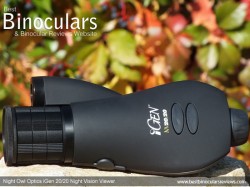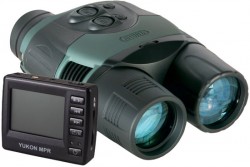How Digital Night Vision Works

The core technology for Digital Night Vision has actually been around for a while, even though in comparison to the more commonly used intensifier tubes on “standard” night vision devices, it is still relatively new. Indeed you may have even already used it on some video cameras that can shoot at night, using what is often referred to as a “0 Lux” mode.
How Digital Night Vision Works
As with a normal night vision binocular or monocular, available light is collected through the objective lens. But instead of focusing this light on an intensifier and converting the energy into electrons, most digital night vision devices process and convert this optical image into an electric signal through a highly sensitive CCD (Charge-Coupled Device) image sensor, similar to what is found in most digital cameras and other imaging devices.
This electrical signal is then transferred onto a micro-display, which is a type of LCD flat-panel display screen in which each pixel is controlled by between one to four transistors. This micro-display technology provides the best resolution of all the flat-panel techniques.
On most Night Vision equipment, the micro-display will probably take the form of an eyepiece which you look into to view the image rather than on an LCD screen as you find on most digital cameras. This is because it is important if you are trying to remain undetected by what you are viewing to keep yourself as inconspicuous as possible.
Main Advantages
Digital Night Vision offers a number of advantages over the more conventional intensifier tube night vision devices.
Price & Performance
 The main one is price – most digital products are cheaper and it can give results that are comparable to earlier Gen 1 devices at less cost and without many of the distortions. For example the Luna Optics LN-DM5 Digital Night Vision Monocular compares with and beats many Gen 1 devices, yet at around $180 / £150 costs quite a bit less than many of them.
The main one is price – most digital products are cheaper and it can give results that are comparable to earlier Gen 1 devices at less cost and without many of the distortions. For example the Luna Optics LN-DM5 Digital Night Vision Monocular compares with and beats many Gen 1 devices, yet at around $180 / £150 costs quite a bit less than many of them.
Up until recently, I would have left it at that as most digital devices don’t compare to the quality of Gen 2 or 3 night vision devices.
However new products like the iGen 20/20 Digital Night Viewer from Night Owl Optics can now compete with many Gen 3 devices in terms of performance and how much you can actually see at night.
Image Quality
As well as this, with a digital device you do not get the image distortion from the photocathode or phosphorescent screen blemishes as you do with intensifier tubes.
 Photo & Video Recording
Photo & Video Recording
Because you are converting the optical image into a digital signal, it is then relatively easy these days to take that signal and store it onto a memory card etc. So you can record what you a seeing as either an image or as a video.
Many digital devices now either have on-board storage or a built-in video output connector that you can use to connect the device to a computer, dedicated recorder or even some hand held video recorders that accept video in like the AIPTEK video recorders.
More Robust
Standard night vision uses rather fragile vacuum tubes and are at risk of damage from bright light exposure. This is not the case with Digital NV devices, indeed many of them can actually be used during the day.
Digital Night Vision Reviews
Below is a selection of the digital night vision products that I have fully tested and reviewed:
Luna Optics LN-DM50-HRSD Digital Night Vision Viewer/ Recorder
 This night vision device does it all. Not only can you see in the dark, but you can now record still images or even video of whatever it is that you are looking at as well!
This night vision device does it all. Not only can you see in the dark, but you can now record still images or even video of whatever it is that you are looking at as well!
This digital night vision monocular is compact, but also boasts a powerful 5x optical magnification that can also be increased digitally up to a maximum of 20x, without a visible loss in picture quality.
Also included is a very powerful IR illuminatior that acts like a torch to the device, but is invisible to us and so can either help you to see in complete darkness or massively improve your view in certain situations.
Price Range
Depending on where you shop and at the time of writing, the cost around $450 / £500:
Luna Optics LN-DM5 Night Vision Monocular
 In almost every area, these low cost digital night vision monoculars from Luna Optics perform well above what their small price tag suggests.
In almost every area, these low cost digital night vision monoculars from Luna Optics perform well above what their small price tag suggests.
They are small as well as lightweight and feature a very powerful built-in IR illuminator for the darkest nights. Their large 50mm objective lens ensures plenty of light is captured and with a powerful 5x magnification these ensure you still get a great view of something a little further away.
The LN-DM5 is in my opinion a great option for anyone wanting an inexpensive, yet great performing device for general home security, to take on camping, hiking and wildlife adventures and especially on a safari holiday.
Price Range
Depending on where you shop and at the time of writing, the cost around $180 / £150:
Read full Review – Read my full review of these Digital Luna Optics Monoculars.
Night Owl iGen 20/20 Night Vision Monocular
 With their striking design, these Nigh Owl Optics digital night vision monoculars produce an image that I thought was as good as some Gen 2 devices that I have used, which is seriously impressive.
With their striking design, these Nigh Owl Optics digital night vision monoculars produce an image that I thought was as good as some Gen 2 devices that I have used, which is seriously impressive.
What is more, with these you can recapture still images as well as video of whatever it is you are looking at.
Other highlights include a 2.6x magnification, built in Infrared illuminator and adjustable light amplification and frame rate which enables you to get a bright and detailed image in very dark conditions.
Price Range
As you would expect, the image capture version of this devices costs a little more, so if you are on a budget and recording is not that important then there is a standard version as well which is cheaper. Expect to pay around $630 / £700 for the capture version and $430 / £560 for the standard one:
Read full Review – Read my full review of the Night Owl iGen Digital Monocular.

 Article | Posted by Best Binocular Reviews
Article | Posted by Best Binocular Reviews 
 Categories:
Categories:  Tags:
Tags: 

Thanks for keeping us up to date on digital night vision tech.